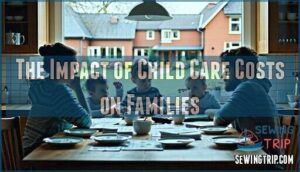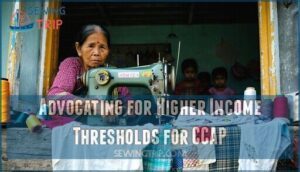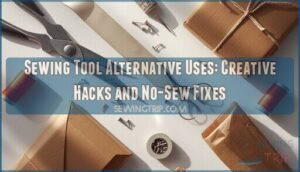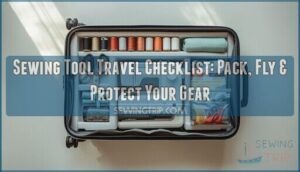This site is supported by our readers. We may earn a commission, at no cost to you, if you purchase through links.

Handmade quilts cost around $25 per square foot, making a queen-size piece about $1,000.
That’s because you’re paying for skilled craftsmanship, premium materials, and dozens of hours of painstaking work.
Mass-produced alternatives run $30-$100, but they lack the artistry and durability.
Hobby quilters at craft fairs might charge less, though quality varies.
The price reflects more than materials – it’s weeks of selecting fabrics, cutting precise pieces, and hand-stitching every detail, which requires painstaking work and results in genuine value.
Understanding what drives these costs can help you spot genuine value.
Table Of Contents
- Key Takeaways
- The Rising Costs of Child Care
- The Impact of Child Care Costs on Families
- The Child Care Assistance Program in Illinois
- Effingham County’s Efforts to Offset Child Care Costs
- The Challenges of Child Care Costs in Urban Areas
- Advocating for Higher Income Thresholds for CCAP
- Understanding The Value of Handmade Quilts
- Determining The Price of Handmade Quilts
- Frequently Asked Questions (FAQs)
- Conclusion
Key Takeaways
- You’ll pay premium prices for authentic patchwork – handmade quilts cost around $25 per square foot, making a queen-size quilt about $1,000 due to skilled craftsmanship and dozens of hours of labor.
- Mass-produced alternatives can’t match the quality – while factory quilts run $30-$100, they lack the artistry, durability, and unique character that comes with handcrafted pieces.
- Material costs and labor drive up prices significantly – you’re paying for premium cotton fabrics, specialized batting, and 20-92 hours of skilled work at $15-$35 per hour.
- The investment pays off in lasting value – unlike cheap alternatives, authentic patchwork quilts offer generational durability and irreplaceable artistry that justifies the higher cost.
The Rising Costs of Child Care
Childcare costs have skyrocketed across Illinois, hitting families where it hurts most.
Between 2008 and 2018, you’ve witnessed a staggering 31.5% increase in childcare expenses. This affordability crisis means you’re now paying an average of $133 weekly, representing nearly 13% of median household income.
Childcare costs jumped 31.5% in just a decade, forcing impossible choices for Illinois families.
The economic impact creates parental stress as quality access becomes increasingly difficult. Even with the Child Care Assistance Program (CCAP) helping families below 225% poverty level, many still struggle.
Effingham County’s $400K program funding from federal relief demonstrates local efforts to address this growing challenge.
The Impact of Child Care Costs on Families
When childcare costs eat up nearly 13% of your household income, tough choices become inevitable.
Financial strain forces impossible decisions between quality care and basic necessities.
You’ll face financial strain** that forces decisions between quality care and paying bills.
Many Illinois families find themselves taking loans or cutting essential expenses just to afford childcare.
This creates a domino effect – parents may reduce work hours or leave jobs entirely, impacting career growth and family well-being.
The ripple effects extend to your child’s development opportunities, as expensive care often means settling for lower-quality options that don’t support early learning.
The Child Care Assistance Program in Illinois
Illinois families struggling with sky-high childcare costs can find relief through the Child Care Assistance Program (CCAP).
CCAP eligibility extends to families earning below 225% of the federal poverty level, creating quality access for those who need it most.
This program helps bridge affordability gaps that prevent families from securing reliable care.
However, advocates push for raising the income threshold to 300%, recognizing that current CCAP eligibility requirements leave many middle-class families without support.
Program awareness remains vital as rising childcare costs in Illinois continue outpacing family incomes, making assistance programs like CCAP essential for working parents across Effingham County and beyond, addressing the need for quality access and reliable care for families struggling with sky-high childcare costs.
Effingham County’s Efforts to Offset Child Care Costs
Looking beyond state-level programs, Effingham County stepped up with local solutions.
The county allocated $400,000 in ARPA funds specifically to help middle-class families who don’t qualify for CCAP but still struggle with childcare costs.
This creative pricing strategy targets families earning between 225-250% of the federal poverty level.
Local allocations like these fill vital gaps that state programs miss.
To foster creativity in children, consider age-appropriate tools for sewing projects.
The county’s awareness efforts guarantee families know about available resources, making quality childcare more accessible for working parents who previously had few options, and providing them with vital gaps and quality childcare and middle-class families.
The Challenges of Child Care Costs in Urban Areas
When you’re addressing childcare costs in urban areas, the affordability gap widens substantially compared to rural communities.
Urban families face a perfect storm of high demand and limited supply that drives prices beyond what many can manage.
The economic impact hits family budgets hard when income thresholds for assistance programs haven’t kept up with actual living costs.
You’ll find that urban affordability becomes nearly impossible when childcare expenses consume a massive chunk of your monthly income.
Urban areas present unique challenges that compound the problem:
- Higher real estate costs mean childcare centers pay more rent, passing expenses to families
- Increased competition for quality providers drives up pricing across all income levels
- Transportation costs add another layer when accessing affordable options requires longer commutes
- Professional demands in urban jobs often require extended hours, increasing childcare needs
Policy solutions must address these urban-specific barriers.
You can’t apply rural pricing models to metropolitan areas where everything costs more.
Quality access shouldn’t depend on your zip code or economic status within the city limits, ensuring equal access to quality childcare is a must, and urban affordability is a significant challenge.
Affordable childcare is essential for urban families, and economic status should not be a barrier to accessing quality care.
Advocating for Higher Income Thresholds for CCAP
You’re not alone in feeling the pinch of rising childcare costs. Current CCAP eligibility caps at 225% of the poverty level, creating an affordability crisis for working families who earn just enough to disqualify but not enough to comfortably afford care.
Advocates push for CCAP expansion to 300% income thresholds, recognizing this economic impact on family stability. This change would help thousands navigate the gap between assistance cutoffs and actual affordability, ensuring quality care access regardless of slight income differences.
The patchwork of current policies leaves many families struggling despite working hard. Sewing skills can offer critical income opportunities to help address this issue, providing a potential solution for families to earn extra income and afford childcare, thus enhancing their overall economic well-being and quality of life.
Understanding The Value of Handmade Quilts
When you’re considering patchwork cost, understanding quilt value goes beyond the price tag.
Each handmade quilt represents a unique artistic creation that you can’t find in stores.
The Quilt Uniqueness stems from custom patterns, personal color choices, and one-of-a-kind stitching that makes your piece irreplaceable.
Craftsmanship Value becomes clear when you realize quilters invest 37-120 hours of skilled labor per project.
This Labor Investment, typically worth $15-35 per hour, adds $130-3,220 to your quilt’s worth.
You’re not just buying bedding—you’re purchasing expertise in fabric selection, precise cutting, intricate piecing, and detailed quilting techniques.
Material Quality substantially impacts patchwork pricing.
Premium cotton fabrics, durable batting, and specialized threads guarantee your quilt lasts generations.
These Pricing Factors justify expensive patchwork costs because you’re investing in materials designed for longevity, comfort, and beauty that mass-produced alternatives simply can’t match.
A throw quilt’s expense can be attributed to the higher material costs needed for its larger size.
Determining The Price of Handmade Quilts
When you’re pricing your handmade quilt, you’ll need to take into account several key factors that determine its market value. Material cost forms your foundation—fabric, batting, and thread typically range from $145 for throws to over $300 for larger quilts.
Labor costs represent your biggest expense, since you’ll invest 20-92 hours depending on design complexity. Most quilters charge $15-35 per hour for their time.
Quilt size directly impacts pricing: baby quilts average $275, while king-size pieces can reach $1,200 or more. Intricate patterns may double your base price compared to simple designs.
A throw-size quilt’s average price is $400, reflecting its inherent value. Use proven formulas for quilting cost analysis: add material costs plus labor, then multiply by two for wholesale or four for retail pricing.
Don’t forget overhead expenses like equipment wear and utilities. Your quilting profit margin should reflect the true value of your skilled craftsmanship, not compete with mass-produced alternatives. To guarantee fair pricing, research competitors’ prices is an essential step.
Frequently Asked Questions (FAQs)
How much does quilt repair cost?
Quilt repair costs vary by damage type and complexity.
Professional quilters typically charge $35-$40 per hour, with simple repairs starting around $50-$
Complex restoration can cost hundreds depending on time needed.
How much does a quilt cost?
Handmade quilts typically cost $200-$800, with queen-sized ones ranging $350-$ You’ll pay based on size, materials, complexity, and craftsmanship – it’s an investment in artistry and time.
Why do quilts cost so much?
You’re paying for skilled craftsmanship, quality materials, and countless hours of detailed handwork. Each quilt requires expensive fabrics, specialized tools, and weeks of painstaking stitching that justifies the price.
How do you Price a damaged quilt?
You’ll need to assess damage extent first, then reduce your standard pricing accordingly.
Minor stains or loose threads might warrant a 10-20% discount, while significant tears or fading could justify 30-50% off retail value.
Are quilts expensive?
Yes, quilts can be expensive.
You’ll pay $200-$800 for handmade ones, depending on size and complexity.
Queen-sized quilts cost $350-$1,500, while baby quilts run $150-$
The price reflects materials, labor, and craftsmanship involved.
Are handmade quilt prices worth it?
You’re paying for genuine craftsmanship, quality materials, and dozens of hours of skilled labor. Handmade quilts cost $200-$800 but offer lasting value that mass-produced alternatives can’t match.
Why is patchwork so popular?
Despite seeming complex, patchwork’s popularity stems from its accessibility and therapeutic benefits. You can start with basic squares, gradually building skills while creating meaningful heirloom pieces that connect generations together.
Is patchwork a good game for couples?
You’ll find patchwork and quilting make fantastic couple activities since you’re collaborating on creative projects together.
You can divide tasks, share design decisions, and enjoy quality time while creating something meaningful for your home.
Is patchwork hard to learn?
Like learning to ride a bike, patchwork starts wobbly but becomes second nature with practice. You’ll master basic stitching quickly, though intricate patterns take time to develop.
Is patchwork a good game?
Patchwork isn’t a game – it’s a textile craft where you sew fabric pieces together to create quilts or decorative items.
You might be thinking of the board game "Patchwork" by Uwe Rosenberg instead.
Conclusion
Ultimately, you’ll find that patchwork expensive prices reflect genuine craftsmanship and quality materials.
Whether you’re buying handmade quilts at $25 per square foot or exploring budget alternatives, understanding these cost factors helps you make informed decisions.
The investment in authentic patchwork pays off through durability and artistry that mass-produced items can’t match.
Consider your needs, budget, and appreciation for traditional craftsmanship when evaluating these timeless pieces.
- https://en.wikipedia.org/wiki/Quilting
- http://www.mooreapproved.com/2015/02/quiltonomics-the-real-cost-of-quilts/
- http://quilts.com/assets/qia_summary.pdf
- https://quiltsbytaylor.com/why-are-quilts-so-expensive/why-are-quilts-so-expensive/
- https://sewnhandmade.com/blogs/sewn-handmade/cost-of-a-handmade-quilt











